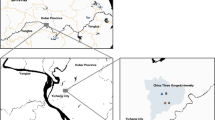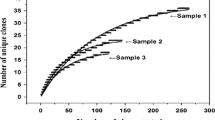Abstract
Hexavalent chromium [Cr(VI)], is a toxic, water-soluble contaminant present in many soils and industrial effluents. Bacteria from various soils were examined for Cr(VI) resistance and reducing potential. Microbes selected from both Cr(VI)-contaminated and-noncontaminated soils and sediments were capable of catalyzing the reduction of Cr(VI) to Cr(III) a less toxic, less water-soluble form of Cr, demonstrating the utility of using a selection strategy for indigenous Cr(VI)-reducing bacteria in a bioprocess. As a result, indigenous Cr(VI)- reducing microbes from contaminated sites should provide the means for developing a bioprocess to reduce Cr(VI) to Cr(III) in nonsterile effluents such as those from soil washes. This approach also avoids the contamination problems associated with pure cultures of allochthonous microorganisms. In addition the apparent ubiquity of Cr(VI)-reducing bacteria in soil and sediments indicates potential for in situ bioremediation of Cr(VI)-contaminated soils and ground water.
Similar content being viewed by others
References
Apel WA, Turick CE (1991) Bioremediation of hexavalent chromium by bacterial reduction. In: Smith RW, Mishra M (eds) Mineral bioprocessing. The Minerals, Metals and Materials Society, Warrensdale, P, pp 376–387
Bopp LH, Ehrlich HL (1988) Chromate resistance and reduction in Pseudomonas fluorescens strain LB300. Arch Microbiol 150: 426–431
Burke T, Fagliano J, Goldoft M, Hazen RE, Inglewicz R, McKee T (1991) Chromite ore processing residue in Hudson County, New Jersey. Environ Health Perspect 92:131–137
Cervantes C (1991) Bacterial interactions with chromate. Antonie van Leeuwenhoek 59:229–233
DeLeo PC, Ehrlich HL (1994) Reduction of hexavalent chromium by Pseudomonas fluorescens LB300 in batch and continuous cultures. Appl Microbiol Biotechnol 40:756–759
Deltombe E, DeZoubov N, Pourbaix M (1974) Chromium. In: Pourbaix M (ed). Atlas of electrochemical equilibria in aqeous solutions. National Association of Corrosion Engineers, Houston, Tex, pp 256–271
Fude L, Harris B, Urrutia MM, Beveridge TJ (1994) Reduction of Cr(VI) by a consortium of sulfate-reducing bacteria (SRB III). Appl Environ Microbiol 60:1525–1531
Fujie K, Tsuchida T, Urano K, Ohtake H (1994) Development of bioreactor system for the treatment of chromate wastewater using Enterobacter cloacae HO-1. Water Sci Technol 30:235–243
Gopalan R, Veeramani H (1994) Studies on microbial chromate reduction by Pseudomonas sp. in aerobic continuous suspended growth cultures. Biotechnol Bioeng 43:471–476
Gvozdyak PI, Mogilevich NF, Ryl'skii AF, Grishchenko NI (1986) Reduction of hexavalent chromium by collection strains of bacteria. Mikrobiologiya 55:962–965
Horitsu H, Futo S, Miyazawa Y, Ogai S, Kawai K (1987) Enzymatic Reduction of hexavalent chromium by hexavalent chromium tolerant Pseudomonas ambigua G-1. Agric Biol Chem 51: 2417–2420
Kvasnikov EI, Stepanyuk VV, Klyushnikova TM, Serpokrylov NS, Simonova GA, Kasatkina TP, Panchenko LP (1985) New gram-variable bacterium which reduces chromium and has a mixed type of flagellation. Mikrobiologiya 54:83–88
Kvasnikov EI, Klyushnikova TI, Kasatkinsa TP, Stepanyuk VV, Kuberskaya SL (1988) Bacteria reducing chromium in nature and in industrial sewage. Mikrobiologiya 57:680–685
Lebedeva EV, Lyalikova NN (1979) Reduction of crocoite by Pseudomonas chromatophila species nova. Mikrobiologiya 48:517–522
Levis AG, Bianchi V (1982) Mutagenic and cytogenic effects of chromium compounds. In: Langard S (ed) Biological and environmental aspects of chromium. Elsevier, Amsterdam, pp 171–208
Lovely DR, Phillips EJP (1994) Reduction of chromat by Desulfovibrio vulgaris and its c 3, cytochrome. Appl Environ Microbiol 60:726–728
Mance G (1987) Pollution threat of heavy metals in aquatic environments. Elsevier Applied Science, New York, NY, pp 31–60, 134–135
Ohtake H, Fujii E, Toda K (1990) A survey of effective electron donors for reduction of toxic hexavalent chromium by Enterobacter cloacae (Strain HO1). J Gen Appl Microbiol 36:203–208
Olson PA, Foster RF (1956) Effect of chronic exposure of sodium dichromate on young Chinook salmon and rainbow trout. (Annual Report for 1955/56, HW 41500:35) Hanford Biological Research, Richland, Wash
Rediske JH (1956) Chromium toxicity in plants. (Annual Report for 1955/56, HW 41500:48) Hanford Biological Research, Richland, Wash
Riley RG, Zachara JM, (1991) Nature of chemical contaminants on DOE lands and identification of representative contaminant mixtures for basic subsurface science research. OHER Subsurface Science Program, PNL, Richland, Wash
Romanenko VI, Korenkov VN, (1977) A pure culture of bacteria utilizing chromates and bichromates as hydrogen acceptors in growth under anaerobic conditions. Mikrobiologia, 46:414–417
Sauter S, Buxton KS, Macek KJ, Petrocelli SR (1976) Effects of exposure of heavy metals on selected freshwater fish. Toxicity of copper, cadmium, chromium and lead to eggs and fry of seven fish species. (EPA-600/3–76–105) US EPA Washington, DC
Wang P, Mori T, Komori K, Sasatsu M, Toda M, Ohtake H (1989) Isolation and characterization of an Enterobacter cloacae strain that reduces hexavalent chromium under anaerobic conditions. Appl Environ Microbiol 55:1665–1669
Wang PC, Toda K, Ohtake H, Kusaka I, Yabe I (1991) Membrane-bound respiratory system of Enterobacter cloacae strain HO1 grown anaerobically with chromate. FEMS Microbiol Lett 78:11–16
Witmer C (1991) Panel discussion: exposure, remediation, and related research needs. Environ Health Perspect 92:139–140
Xing L, Okrent D (1993) Future risk from a hypothesized RCRA site disposing of carcinogenic metals should a loss of societal memory occur. J Hazard Mater 38:363–384
Author information
Authors and Affiliations
Rights and permissions
About this article
Cite this article
Turick, C.E., Apel, W.A. & Carmiol, N.S. Isolation of hexavalent chromium-reducing anaerobes from hexavalent-chromium-contaminated and noncontaminated environments. Appl Microbiol Biotechnol 44, 683–688 (1996). https://doi.org/10.1007/BF00172503
Received:
Revised:
Accepted:
Issue Date:
DOI: https://doi.org/10.1007/BF00172503




